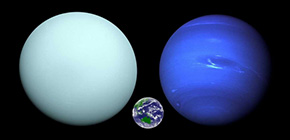
“Metallic water” inside Uranus clarified through laser-driven decaying shocks
Uranus and Neptune, the two planets of the solar system located farthest from the sun, are 4 times larger and 15~16 times more massive than Earth. The atmosphere of these ice giants is primarily composed of water along with traces of carbon and nitrogen molecules, such as methane (CH 4 ) and ammonia (NH 3 ). Because of their size, the temperature and pressure in the interiors of these ice giants are extremely high.
Voyager 2, the space probe that visited Uranus and Neptune in the 1980s, clarified that these two ice giants possessed an internally generated magnetic field tens of times that of Earth. To generate such strong magnetic fields, it is necessary for a strong electric current to continue to flow inside the icy planet. However, because water does not conduct electricity, it was unreasonable to think that such an electric current could exist inside the planets, and the mechanism of the magnetic fields remained unknown.
This group performed experiments to clarify the origin of the magnetic fields of the giant icy planets at the GEKKO XII in Japan and the LULI2000 laser facilities in France using standard optical diagnostics (Doppler velocimetry and optical pyrometry). Using laser-driven shocks, the researchers compressed pure water, a water-ethanol mixture (WEM), and a water-ethanol-ammonia mixture “synthetic planetary mixture” (SPM). These are representative components of the interiors of Uranus and Neptune. The researchers achieved a pressure of about 3 megabar (Mbar), which is equal to the pressure in the interiors of the planets.
However, it is impossible to maintain the pressure obtained by this method at the same level over a very short period of time (one billionth of a second). Thus, they measured the Doppler shift of laser light reflected off the target surface using a Streaked Optical Pyrometer (SOP) system in order to examine the thermodynamic state of the shocked sample, including pressure, density, temperature, and the optical reflectivity of the shock front.
As a result, for all liquids, the reflectivity along the principal Hugoniot increased gradually, which indicates a smooth transition from an insulating state to an electronically conducting (“metallic”) state. In addition, reflectivity increases as the electrical conductivity increases. In experiments, the reflectivity of the mixtures containing carbon (that is, solutions with ethanol) was higher than that of pure water.
From these results, the researchers concluded that the origin of magnetic fields deep in the interiors of these planets was an electric current that flows in a “metallic state of water” and that carbon ions generated by decomposition of CH 4 in the water affected the quality of water.
When compressed through laser-driven decaying shocks, SPM became an electronically conducting (“metallic”) state. Since the reflectivity of the mixtures containing carbon increased, it is thought that strong magnetic fields in Uranus and Neptune originate from electric current in the metallic fluid.

Figure 1

Figure 2

Figure 3
The article, “Laser-driven shock compression of "synthetic planetary mixtures" of water, ethanol, and ammonia,” was published in Scientific Reports at DOI: https://doi.org/10.1038/s41598-019-46561-6 .
Related links
